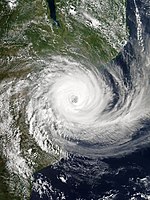
Photo from wikipedia
Abstract Humanitarian disasters such as Typhoon Haiyan (SE Asia, 2013) and the Horn of Africa drought (2011–2012) are examples of natural hazards that were predicted, but where forecasts were not… Click to show full abstract
Abstract Humanitarian disasters such as Typhoon Haiyan (SE Asia, 2013) and the Horn of Africa drought (2011–2012) are examples of natural hazards that were predicted, but where forecasts were not sufficiently acted upon, leading to considerable loss of life. These events, alongside international adoption of the Sendai Framework for Disaster Risk Reduction, have motivated efforts to enable early action from early warnings. Through initiatives such as Forecast-based Financing (FbF) and the Science for Humanitarian Emergencies and Resilience (SHEAR) programme, progress is being made towards the use of science and forecasts to support international humanitarian organisations and governments in taking early action and improving disaster resilience. However, many challenges remain in using forecasts systematically for preparedness and response. The research community in place through SHEAR enabled the UK government's Department for International Development to task a collaborative group of scientists to produce probabilistic real-time flood forecast and risk bulletins, aimed at humanitarian decision-makers, for Cyclones Idai and Kenneth, which impacted Mozambique in 2019. The process of bulletin creation during Idai and Kenneth is reviewed and critically evaluated, including evaluation of the forecast information alongside evidence for how useful the bulletins were. In this context, this work seeks to navigate the “murky landscape” of national and international mandates, capacities, and collaborations for forecasting, early warning and anticipatory action, with the ultimate aim of finding out what can be done better in the future. Lessons learnt and future recommendations are discussed to enable better collaboration between producers and users of forecast information.
Journal Title: International journal of disaster risk reduction
Year Published: 2020
Link to full text (if available)
Share on Social Media: Sign Up to like & get
recommendations!